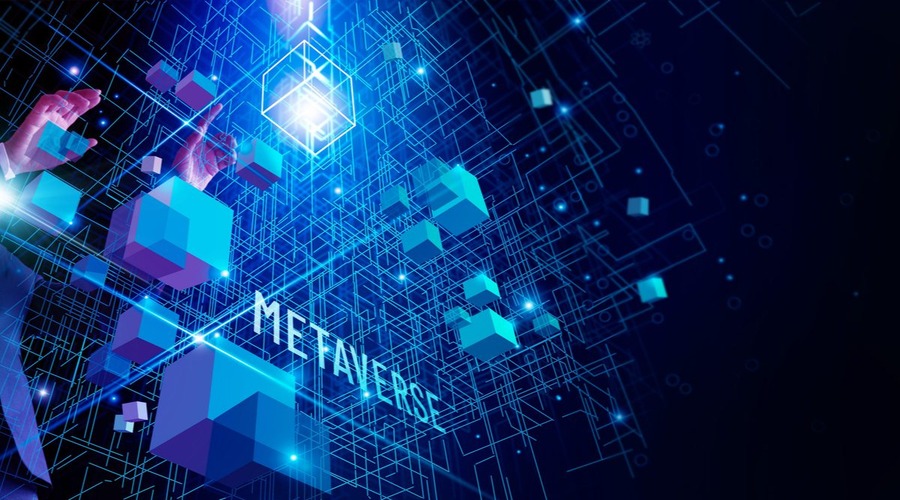The world is experiencing a paradigm shift with the emergence of the metaverse, a virtual space where people can interact, create, and conduct business in a simulated environment. As this concept gains traction, ensuring trust, security, and ownership within the metaverse becomes crucial. This is where blockchain technology, the foundation of cryptocurrencies like Bitcoin, steps in to revolutionize the metaverse and address its challenges.
Understanding the Metaverse
Before diving into the role of blockchain in the metaverse, let’s understand what the metaverse is. The metaverse refers to an interconnected network of virtual reality (VR) and augmented reality (AR) environments. It offers a seamless digital realm where users can engage in various activities, such as socializing, gaming, shopping, and even working. It blurs the boundaries between the physical and digital worlds, providing immersive experiences and endless possibilities.
The Need for Trust and Security in the Metaverse
In the metaverse, where digital interactions are predominant, trust and security are paramount. Users need assurance that their identities, assets, and transactions are protected from fraud, theft, and manipulation. This is where blockchain technology shines.
Ensuring Data Integrity
Blockchain operates on a distributed ledger system, where data is recorded and stored across a network of computers. This decentralized nature makes it highly resistant to tampering, ensuring the integrity of data within the metaverse. Any changes made to the blockchain are transparently recorded, creating an immutable audit trail.
Preventing Fraud and Identity Theft
The metaverse is a potential target for cybercriminals seeking to exploit vulnerabilities. Blockchain’s cryptographic techniques and consensus algorithms provide a robust layer of security, making it difficult for bad actors to manipulate transactions, steal identities, or engage in fraudulent activities. By decentralizing trust, blockchain eliminates the need for intermediaries, reducing the risk of data breaches and unauthorized access.
How Blockchain Technology Works
To grasp the role of blockchain in the metaverse, it’s important to understand how blockchain technology works. At its core, a blockchain is a distributed ledger that securely records transactions and data. Here are some key aspects of blockchain technology:
Distributed Ledger
A blockchain consists of a network of computers (nodes) that collectively maintain a shared ledger. Each node independently verifies and validates transactions before adding them to a block. Once a block is validated, it is linked to the previous block, creating an unbroken chain of blocks—hence the name “blockchain.”
Immutable and Transparent
Once data is recorded on the blockchain, it becomes virtually immutable. Altering a single block would require the consensus and collaboration of the entire network, making it highly impractical and nearly impossible. The transparency of the blockchain allows anyone to view and verify transactions, ensuring accountability.
Smart Contracts
Smart contracts are self-executing contracts with the terms of the agreement directly written into code. They automatically execute predefined actions when specific conditions are met. Smart contracts play a vital role in the metaverse by facilitating peer-to-peer transactions, managing digital assets, and enforcing rules and agreements within virtual environments.

Blockchain and the Metaverse: A Perfect Match
Blockchain technology and the metaverse are a natural fit due to their shared principles and benefits. Here’s why blockchain is essential in the metaverse:
Decentralization and Ownership
Blockchain eliminates the need for centralized authorities or intermediaries, giving users full control and ownership of their digital assets. In the metaverse, where virtual properties, avatars, and virtual currencies hold significant value, blockchain ensures that users have the freedom to buy, sell, trade, and transfer assets securely without relying on a centralized governing body.
Interoperability and Standardization
Different virtual reality platforms and games within the metaverse often operate in silos, hindering seamless interactions and asset transfers. Blockchain’s interoperability features allow for the exchange of assets and data across different platforms, creating a unified and interconnected metaverse. By establishing open standards, blockchain technology fosters collaboration and encourages innovation.
Digital Asset Creation and Management
Blockchain enables the creation, ownership, and management of digital assets within the metaverse. Whether it’s virtual real estate, in-game items, or unique avatars, blockchain-based systems provide a transparent and secure way to authenticate, trade, and prove ownership of these assets. This brings real-world scarcity and value to virtual goods, fueling the growth of the metaverse economy.
Use Cases of Blockchain in the Metaverse
Blockchain technology offers numerous use cases within the metaverse. Here are a few notable examples:
Virtual Real Estate
In the metaverse, virtual real estate represents digital land that users can buy, develop, and monetize. Blockchain provides a secure and transparent platform for buying and selling virtual properties. It also enables the creation of unique virtual land tokens, allowing users to prove ownership and trade their digital real estate assets freely.
Digital Identity
Managing digital identities is crucial in the metaverse, where users interact and conduct transactions. Blockchain offers a decentralized identity management system, ensuring privacy, security, and interoperability. Users can have self-sovereign identities, giving them control over their personal data and enabling seamless verification across different virtual platforms.
In-Game Economies
Many metaverse experiences involve virtual economies where users can earn and spend virtual currencies. Blockchain-powered in-game economies provide transparency, security, and ownership of digital assets. It allows players to trade items, earn rewards, and participate in decentralized marketplaces, fostering a thriving and dynamic gaming ecosystem.
Challenges and Limitations
While blockchain holds great promise for the metaverse, several challenges and limitations need to be addressed:
Scalability
Blockchain networks face scalability issues when it comes to handling a high volume of transactions. As the metaverse grows in popularity and user activity increases, blockchain platforms must find ways to scale without sacrificing speed and efficiency.
Energy Consumption
Blockchain mining, particularly in proof-of-work consensus algorithms, consumes significant amounts of energy. This poses environmental concerns and may hinder the widespread adoption of blockchain technology within the energy-conscious metaverse community. Efforts are underway to develop more energy-efficient consensus mechanisms.
User Experience
Blockchain technology, although powerful, is still relatively complex for the average user. To achieve mass adoption in the metaverse, user interfaces and interactions need to be intuitive and user-friendly. Simplifying the onboarding process and enhancing the overall user experience will be crucial in making blockchain accessible to all.
Future Implications and Opportunities
The integration of blockchain technology into the metaverse has far-reaching implications and opens up exciting opportunities. As the metaverse evolves, blockchain’s role in ensuring trust, security, and ownership will become increasingly vital. It has the potential to redefine how we interact, create, and transact within virtual environments, unlocking new avenues for innovation, collaboration, and economic growth.
- Blockchain integration in the metaverse opens up opportunities for secure and decentralized virtual economies.
- Digital asset ownership and provenance can be assured through blockchain, creating new possibilities for digital art, collectibles, and virtual real estate.
- Interoperability between different virtual reality platforms can be achieved, fostering seamless experiences and collaboration.
- Blockchain-powered metaverse identities enable users to have control over their personal data and enhance privacy.
- Smart contracts in the metaverse facilitate automated transactions and enforce rules without the need for intermediaries.
- The metaverse combined with blockchain technology has the potential to revolutionize industries such as gaming, entertainment, e-commerce, and virtual education.
- The growth of the metaverse and blockchain integration could lead to the emergence of new job roles and economic opportunities.
- Blockchain-based metaverse ecosystems can empower creators, enabling them to monetize their creations and engage with a global audience.
- The metaverse, powered by blockchain, can foster digital inclusion by providing opportunities for participation and economic empowerment to a wider range of individuals.
- As the metaverse evolves, innovative applications and use cases of blockchain technology are likely to emerge, reshaping the way we interact, transact, and experience the digital world.
Conclusion
The metaverse represents a new frontier in human interaction and digital experiences. With the rise of virtual reality and augmented reality technologies, the need for trust, security, and ownership within the metaverse becomes paramount. Blockchain technology provides the foundation for creating a trustworthy and secure metaverse ecosystem. Its decentralized nature, data integrity, and smart contract capabilities make it a perfect match for the metaverse’s evolving needs. By leveraging blockchain’s power, the metaverse can flourish as a vibrant, interconnected, and user-centric digital realm.
FAQs
Q1. Can blockchain ensure the security of transactions and digital assets in the metaverse?
Yes, blockchain technology provides robust security measures to protect transactions and digital assets in the metaverse. Its decentralized and immutable nature makes it highly resistant to tampering and fraud.
Q2. Will blockchain solve the issue of interoperability between different virtual reality platforms?
Blockchain’s interoperability features hold the potential to address the challenge of interoperability in the metaverse. By establishing open standards and protocols, blockchain can enable seamless asset transfers and interactions across different virtual reality platforms.
Q3. How does blockchain enhance the value of virtual real estate in the metaverse?
Blockchain enables the creation of unique virtual land tokens, which represent ownership of digital real estate in the metaverse. These tokens provide a transparent and secure way to authenticate, trade, and prove ownership of virtual properties, bringing real-world scarcity and value to virtual real estate.
Q4. What are the key environmental concerns associated with blockchain in the metaverse?
Blockchain mining, particularly in proof-of-work consensus algorithms, consumes significant amounts of energy. This energy consumption raises concerns about the environmental impact of blockchain technology. However, efforts are underway to develop more energy-efficient consensus mechanisms.
Q5. How will the integration of blockchain and the metaverse impact the future of digital experiences?
The integration of blockchain and the metaverse holds tremendous potential to redefine digital experiences. It enables trust, security, and ownership within virtual environments, paving the way for innovative collaborations, decentralized economies, and immersive user interactions. The future of the metaverse looks promising with blockchain technology at its core.
